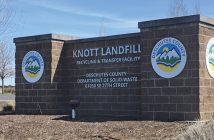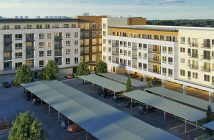(Artist concept of Amphitheater, following full development of the OSU-Cascades campus | Rendering courtesy of OSU-Cascades)
Starting this summer and over the next few decades, the Oregon State University — Cascades campus will expand onto adjacent university-owned properties, creating a 128-acre university campus for 3,000 to 5,000 students. The transformation of the lands — a former pumice mine and former Deschutes County demolition landfill — has been called one of the most innovative university development projects in the country by engineering experts involved. A long range development plan devoted to the campus development earned an award in 2018 for excellence in design from the national Society of University and College Planners.
Envisioned with and for the Community
The future campus plans — with ten miles of walking and biking trails, an amphitheater, an innovation district, restaurants and coffee shops, and ball fields and community housing, reflect input of more than 1,500 community members. Faculty and student input also helped inform space for research, classrooms and labs, as well as informal spaces where students can study or gather.
Goal: A Net Zero Water, Energy and Waste Campus
Net zero would mean the campus consumes only as much energy as it produces, balances water availability and demand, and eliminates waste sent to landfills. It’s a tall order, but campus planners believe net zero goals are right for OSU-Cascades and the community. Campus buildings will aim for high levels of energy efficiency, campus landscaping uses native plants that require minimum water, and students are already learning how to leave the world better for future generations.
Increased Industry Connections
Connections between OSU-Cascades and regional businesses, nonprofits and government agencies have created student internships and jobs, research opportunities and classroom case studies. They were also the impetus for the OSU-Cascades FORCE Lab, a biomechanics lab; the Innovation Co-Lab, an incubator for startups and the Human Ecosystem Resiliency and Sustainability Lab, where researchers look for ways to better sustain human and natural life. Industry connections also helped launch OnBoard Dynamics, the Bend campus’s first spin-off company. These connections have also helped build degree programs that meet the needs of Central Oregon companies, like energy systems engineering, hospitality management and an anticipated degree in outdoor products. The future campus’s innovation district, where businesses can access researchers and interns, will mean connections — and real world solutions — can have even more impact.
Growing Impact of Research
OSU-Cascades’ research programs are growing and tackling a wide range of challenges. Researcher Shannon Lipscomb was awarded a $1.5 million grant to look at how teachers and child care providers can encourage resilience in preschool children who have experienced trauma. Engineer Bahman Abbasi has received more than $4.9 million from the U.S. Department of Energy to develop new technologies to turn salt water into drinking water, and to recover grey water from hydraulic fracturing wastewater. As OSU-Cascades faculty increase in numbers, so too can their impact on our community and world.
Teaching in a Changing World
At OSU-Cascades, faculty are piloting new teaching methods, and will continue to emphasize teaching on the expanded campus, too. Tomorrow’s classrooms will be a contrast to the large lecture halls of the past. A professor may teach in-the-round, surrounded by students. Lectures may sit online, leaving class time for dedicated discussion. And technology will transform the classroom experience.
OSUcascades.edu/campus-expansion
Expansion Begins: Phase 1A
The campus expansion will occur in phases, guided by a campus master plan. Phase 1A commences in August and is anticipated to conclude in summer 2021. It includes:
Site Remediation and Reclamation to transform the mine and landfill into developable lands.
Campus Infrastructure including streets, sidewalks and parking, as well as features including an amphitheater and an oval green.
Off-Campus Infrastructure will benefit the growing Bend community and include:
- New Roundabout — SW Colorado Ave. and Columbia St.
- New Pedestrian/Bike Path — campus entrance on SW Simpson Ave. to SW Century Dr.
Academic Building The 50,000 sq. ft. building will be devoted to STEAM disciplines of science, technology, engineering, arts and mathematics. It will include classrooms, labs, maker spaces and collaborative spaces.





